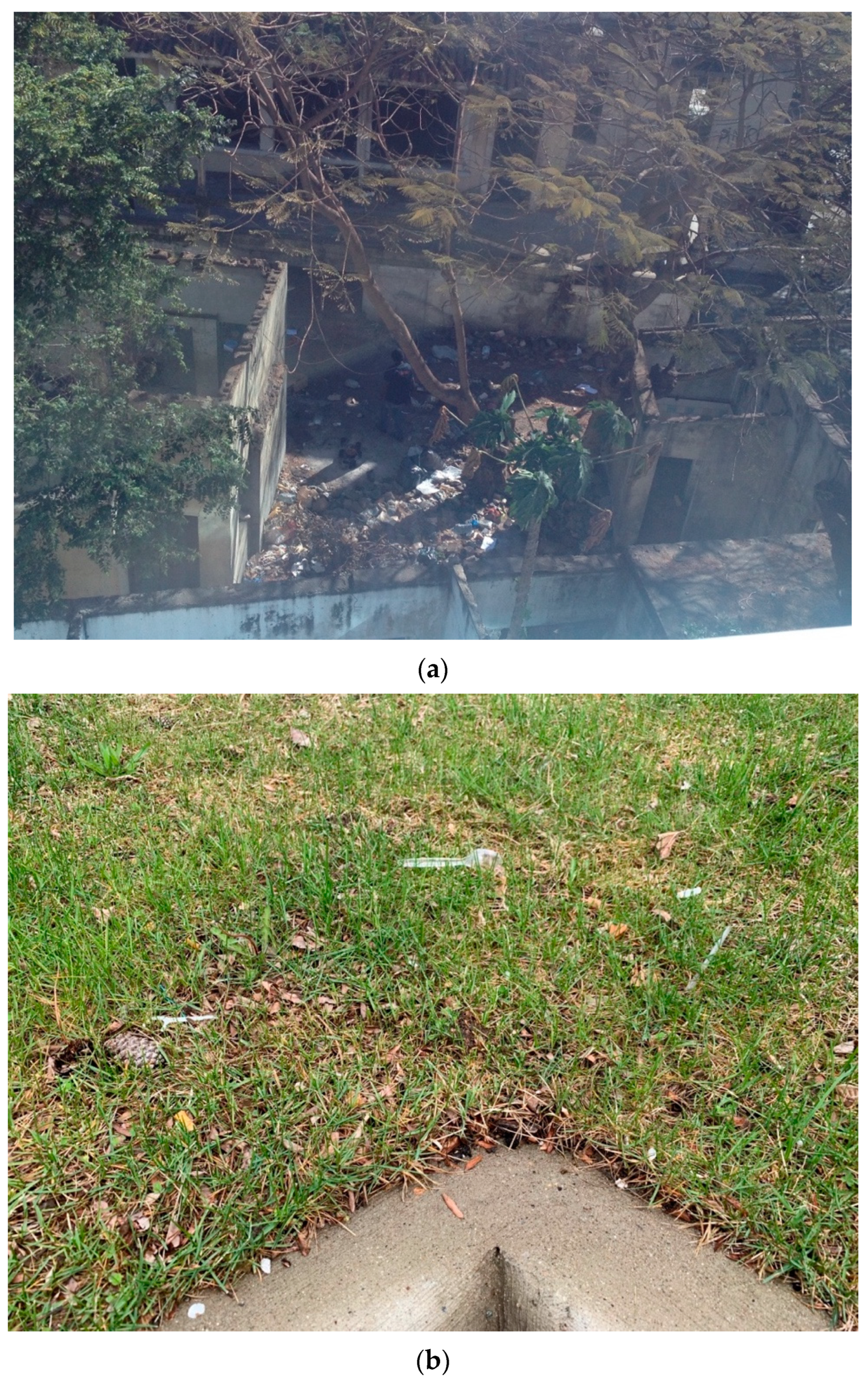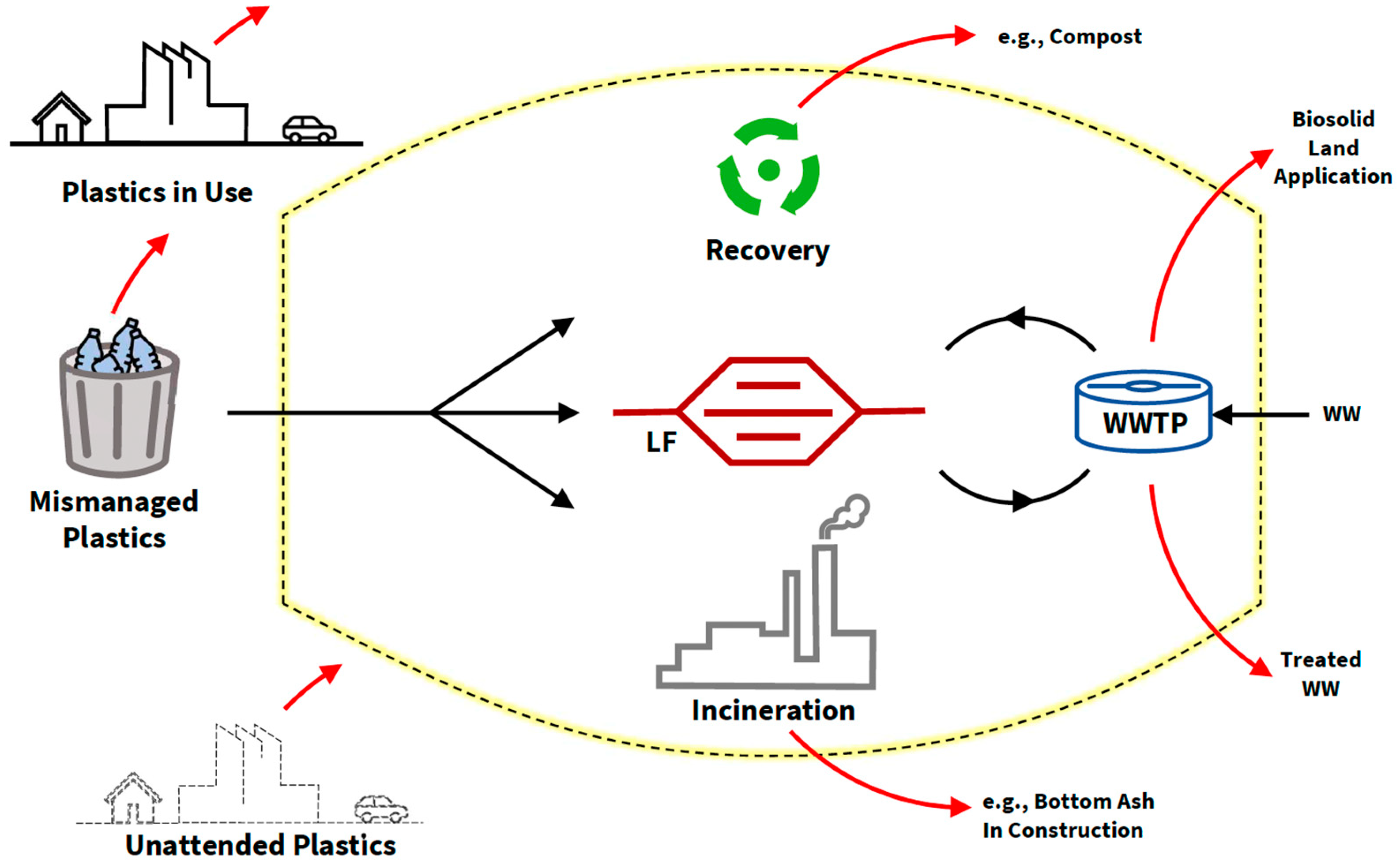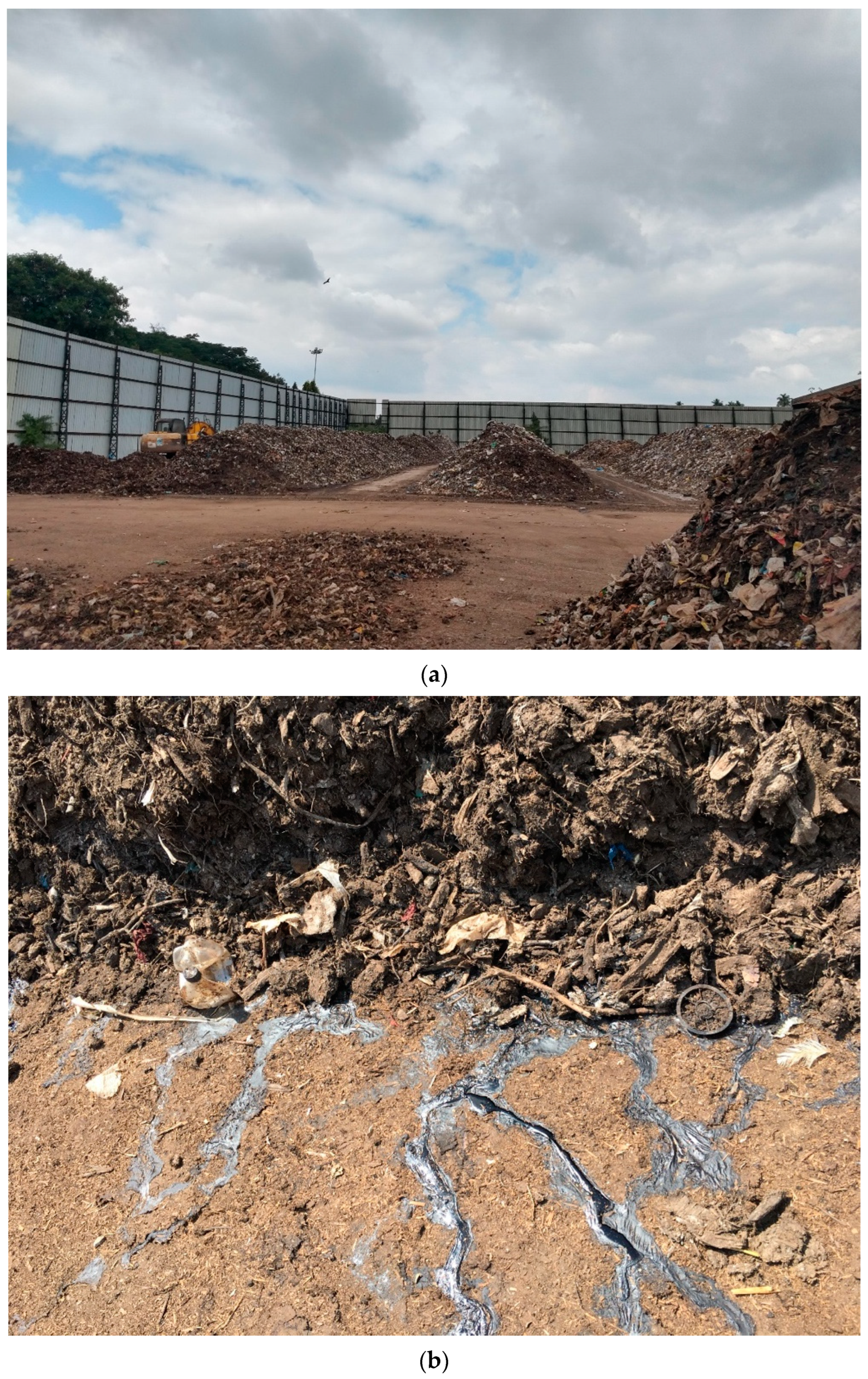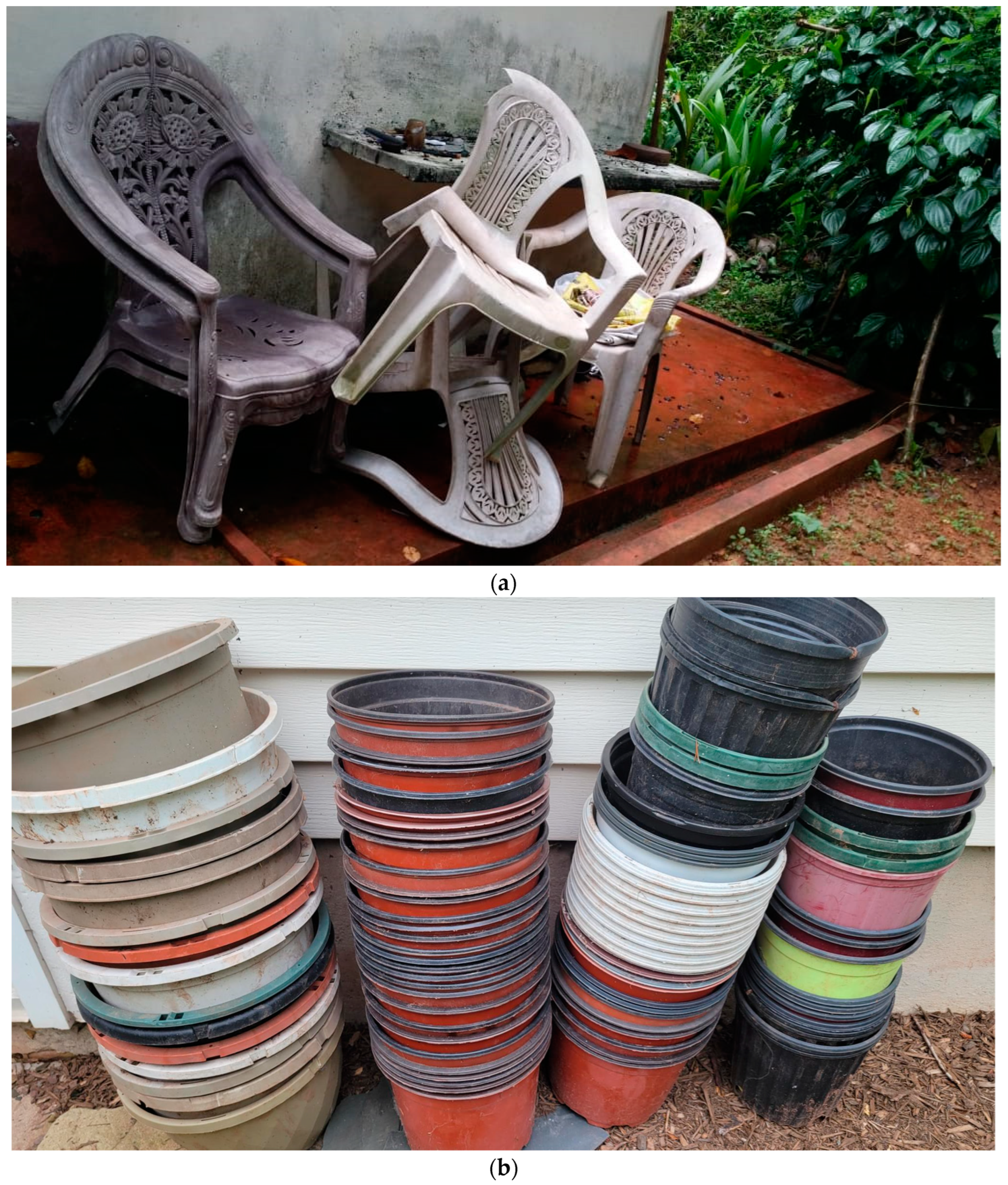Microplastic Pollution Prevention: The Need for Robust Policy Interventions to Close the Loopholes in Current Waste Management Practices
Abstract
1. Introduction
2. Background
2.1. From the Source into the Environment
2.2. From the Environment into the Human Body
2.3. Combatting MPs: Remediation Versus Prevention
3. Status of MP Pollution Preventive Actions around the Globe
3.1. Recent Country-Specific Examples
3.2. Global Efforts
4. Preventive Measures Falling through the Cracks in Waste Management
4.1. Plastic Waste Statistics
4.2. MP Escape Routes in Waste Management
5. The Need for Robust Policy Interventions
5.1. What Is Missing?
5.2. How Can These Gaps Be Filled?
- Obtaining Additional Data. “What is not measured, can never be managed or improved” is a line popular in all kinds of natural and social science disciplines. This is quite true about MP pollution as well. Enhancement of plastic waste management activities cannot guarantee the desired results until all MP escapes routes within waste management are shut. For this, the escape pathways and relative proportions of MP flows through these routes need to be researched, investigated, and estimated. This will allow for immediate action through diverting funds and paying attention to blocking the most damaging pathways.
- Closing the MP cycle between landfills and WWTPs. Arguably, this is one aspect that is already causing severe damage. The cyclical movement of MPs between landfills and WWTPs provides sufficient time for larger MPs to produce finer secondary MPs that are ultimately released by WWTPs (Figure 2). As discussed, even advanced WWTPs are not able to retain the finest 10% of the MPs, which continue to flow out to the environment together with treated wastewater. Policy interventions are needed to mandate and equip WWTPs to retain as much MP pollution as possible as well as to guarantee safe final disposal of captured MPs.
- Enforcing quality control measures for recovery/upcycling associated with plastics. The above discussion illustrates examples of MP escape through recovery such as land application of biosolids, organic waste composting, and upcycling of bottom ash from incineration. These examples represent sustainable recovery methods. Therefore, any MP pollution preventive actions should be designed in such a way as to not discourage sustainable practices. On the other hand, any new policy interventions can be built on the idea of “plastic-free recovery.” As an example, plastic pollution is certainly unwelcomed by the composting industry and users alike (Figure 3). Enforcing stricter quality control measures to weed out MPs will be beneficial for the composting industry. Similarly, unburned plastics in bottom ash reflects a certain inefficiency associated with the incineration process that could be resolved through stricter environmental laws.
- Disposal of unattended plastic items. As illustrated in Figure 2, a certain fraction of plastic items is neither in use nor labelled as waste. These may be old/abandoned plastic items stacked in garages, barns, backyards, warehouses, or offices (Figure 4). These unattended plastics are not contributing to any meaningful activities in the economy or society, while continuing to release MPs into the environment. It is not easy to estimate the relative size of this fraction. However, observing such items pretty much everywhere in almost all communities, the total volume of unattended plastics could be sufficiently large enough to receive attention. Although it may be difficult to impose a national-level ban on “hoarding” of old/unattended plastics, effective interventions could be made through local/regional policies such as city ordinances. One good example to learn from is how countries have eradicated mosquito-borne diseases by introducing laws/campaigns to remove any potential mosquito breeding grounds from peoples’ backyards, such as unattended cups, cans, buckets, old tires, etc. [67,68].
6. Conclusions
- Obtaining additional data needed for prevention planning.
- Closing the MP loop between landfills and WWTPs.
- Enforcing quality control measures on recovery/upcycling associated with plastics.
- Proper disposal of unattended plastics items.
Author Contributions
Funding
Institutional Review Board Statement
Informed Consent Statement
Data Availability Statement
Conflicts of Interest
References
- Napper, I.E.; Thompson, R.C. “Plastics: From a Success Story to an Environmental Problem and a Global Challenge”. Global Challenges. Microplastics 2020, 4, 1900081. [Google Scholar] [CrossRef]
- Gigault, J.; ter Halle, A.; Baudrimont, M.; Pascal, P.-Y.; Gauffre, F.; Phi, T.-L.; El Hadri, H.; Grassl, B.; Reynaud, S. Current opinion: What is a nanoplastic? Environ. Pollut. 2018, 235, 1030–1034, ISSN 0269-7491. [Google Scholar] [CrossRef]
- Patel, M.M.; Goyal, B.R.; Bhadada, S.V.; Bhatt, J.S.; Amin, A.F. Getting into the brain: Approaches to enhance brain drug delivery. CNS Drugs 2009, 23, 35–58. [Google Scholar] [CrossRef]
- Corcoran, P.L. Degradation of MP in the Environment. In Handbook of MP in the Environment; Rocha-Santos, T., Costa, M., Mouneyrac, C., Eds.; Springer: Cham, Switzerland, 2021. [Google Scholar] [CrossRef]
- Ter Halle, A.; Ladirat, L.; Gendre, X.; Goudounèche, D.; Pusineri, C.; Routaboul, C.; Tenailleau, C.; Duployer, B.; Perez, E. Understanding the fragmentation pattern of marine plastic debris. Environ. Sci. Technol. 2016, 50, 5668–5675. [Google Scholar] [CrossRef]
- Liu, P.; Zhan, X.; Wu, X.; Li, J.; Wang, H.; Gao, S. Effect of weathering on environmental behavior of microplastics: Properties, sorption and potential risks. Chemosphere 2020, 242, 125193. [Google Scholar] [CrossRef] [PubMed]
- Mortula, M.; Atabay, S.; Fattah, K.P.; Madbuly, A. Leachability of microplastic from different plastic materials. J. Environ. Manag. 2021, 294, 112995. [Google Scholar] [CrossRef] [PubMed]
- Fadli, M.H.; Ibadurrohman, M.; Slamet, S. Microplastic Pollutant degradation in water using modified TiO2 photo-catalyst under UV-irradiation. IOP Conf. Ser. Mater. Sci. Eng. 2021, 1011, 012055. [Google Scholar] [CrossRef]
- Bhatt, P.; Pathak, V.M.; Bagheri, A.R.; Bilal, M. Microplastic contaminants in the aqueous environment, fate, toxicity consequences, and remediation strategies. Environ. Res. 2021, 200, 111762. [Google Scholar] [CrossRef] [PubMed]
- Li, J.; Song, Y.; Cai, Y. Focus topics on MP in soil: Analytical methods, occurrence, transport, and ecological risks. Environ. Pollut. 2020, 257, 113570. [Google Scholar] [CrossRef]
- Huang, C.; Ge, Y.; Yue, S.; Zhao, L.; Qiao, Y. Microplastics aggravate the joint toxicity to earthworm Eisenia fetida with cadmium by altering its availability. Sci. Total Environ. 2021, 753, 142042. [Google Scholar] [CrossRef]
- Wiesinger, H.; Wang, Z.; Hellweg, S. Deep Dive into Plastic Monomers, Additives, and Processing Aids. Environ. Sci. Technol. 2021, 55, 9339–9351. [Google Scholar] [CrossRef]
- Ma, Y.; Liu, H.; Wu, J.; Yuan, L.; Wang, Y.; Du, X.; Wang, R.; Marwa, P.W.; Petlulu, P.; Chen, X.; et al. The adverse health effects of bisphenol A and related toxicity mechanisms. Environ. Res. 2019, 176, 108575. [Google Scholar] [CrossRef] [PubMed]
- Meegoda, J.N.; Hettiarachchi, M.C. A Path to a Reduction in Micro and Nanoplastics Pollution. Int. J. Environ. Res. Public Health 2023, 20, 5555. [Google Scholar] [CrossRef] [PubMed]
- Murphy, F.; Ewins, C.; Carbonnier, F.; Quinn, B. Wastewater Treatment Works (WwTW) as a Source of Microplastics in the Aquatic Environment. Environ. Sci. Technol. 2016, 50, 5800–5808. [Google Scholar] [CrossRef] [PubMed]
- Freeman, S.; Booth, A.M.; Sabbah, I.; Tiller, R.; Dierking, J.; Klun, K.; Rotter, A.; Ben-David, E.; Javidpour, J.; Angel, D.L. Between source and sea: The role of wastewater treatment in reducing marine MP. J. Environ. Manag. 2020, 266, 110642. [Google Scholar] [CrossRef]
- Dey, T.K.; Uddin, M.E.; Jamal, M. Detection and removal of MP in wastewater: Evolution and impact. Environ. Sci. Pollut. Res. 2021, 28, 16925–16947. [Google Scholar] [CrossRef]
- Carr, S.A.; Liu, J.; Tesoro, A.G. Transport and fate of microplastic particles in wastewater treatment plants. Water Res. 2016, 91, 174–182. [Google Scholar] [CrossRef]
- Golwala, H.; Zhang, X.; Iskander, S.M.; Smith, A.L. Solid waste: An overlooked source of microplastics to the environment. Sci. Total Environ. 2021, 769, 144581. [Google Scholar] [CrossRef]
- Dessì, C.; Okoffo, E.D.; O’brien, J.W.; Gallen, M.; Samanipour, S.; Kaserzon, S.; Rauert, C.; Wang, X.; Thomas, K.V. Plastics contamination of store-bought rice. J. Hazard. Mater. 2021, 416, 125778. [Google Scholar] [CrossRef]
- Du, F.; Cai, H.; Zhang, Q.; Chen, Q.; Shi, H. Microplastics in take-out food containers. J. Hazard. Mater. 2020, 399, 122969. [Google Scholar] [CrossRef]
- Liu, X.; Sun, P.; Qu, G.; Jing, J.; Zhang, T.; Shi, H.; Zhao, Y. Insight into the characteristics and sorption behaviors of aged poly-styrene MP through three type of accelerated oxidation processes. J. Hazard. Mater. 2021, 407, 124836. [Google Scholar] [CrossRef] [PubMed]
- Khalid, N.; Aqeel, M.; Noman, A. Microplastics could be a threat to plants in terrestrial systems directly or indirectly. Environ. Pollut. 2020, 267, 115653. [Google Scholar] [CrossRef]
- Lai, H.; Liu, X.; Qu, M. Nanoplastics and Human Health: Hazard Identification and Biointerface. Nanomaterials 2022, 12, 1298. [Google Scholar] [CrossRef] [PubMed]
- Thiele, C.J.; Hudson, M.D.; Russell, A.E.; Saluveer, M.; Sidaoui-Haddad, G. Microplastics in fish and fishmeal: An emerging environmental challenge? Sci. Rep. 2021, 11, 2045. [Google Scholar] [CrossRef] [PubMed]
- Li, L.; Luo, Y.; Li, R.; Zhou, Q.; Peijnenburg, W.J.G.M.; Yin, N.; Yang, J.; Tu, C.; Zhang, Y. Effective uptake of submicrometre plastics by crop plants via a crack-entry mode. Nat. Sustain. 2020, 3, 929–937. [Google Scholar] [CrossRef]
- WHO. MP in Drinking Water; Technical Report; World Health Organization: Geneva, Switzerland, 2019. [Google Scholar]
- Johnson, A.C.; Ball, H.; Cross, R.; Horton, A.A.; Jürgens, M.D.; Read, D.S.; Vollertsen, J.; Svendsen, C. Identification and Quantification of Microplastics in Potable Water and Their Sources within Water Treatment Works in England and Wales. Environ. Sci. Technol. 2020, 54, 12326–12334. [Google Scholar] [CrossRef]
- Shen, M.; Song, B.; Zhu, Y.; Zeng, G.; Zhang, Y.; Yang, Y.; Wen, X.; Chen, M.; Yi, H. Removal of microplastics via drinking water treatment: Current knowledge and future directions. Chemosphere 2020, 251, 126612. [Google Scholar] [CrossRef]
- Kirstein, I.V.; Gomiero, A.; Vollertsen, J. Microplastic pollution in drinking water. Curr. Opin. Toxicol. 2021, 28, 70–75. [Google Scholar] [CrossRef]
- E Oßmann, B. Microplastics in drinking water? Present state of knowledge and open questions. Curr. Opin. Food Sci. 2021, 41, 44–51. [Google Scholar] [CrossRef]
- Negrete, V.A.; Ramseier, G.S.; Zimmermann, S.; Stoll, S. Contamination and Removal Efficiency of Microplastics and Synthetic Fibres in a Conventional Drinking Water Treatment Plant. Front. Water 2022, 4, 835451. [Google Scholar] [CrossRef]
- Mason, S.A.; Welch, V.G.; Neratko, J. Synthetic Polymer Contamination in Bottled Water. Front. Chem. 2018, 6, 407. [Google Scholar] [CrossRef]
- Zuccarello, P.; Ferrante, M.; Cristaldi, A.; Copat, C.; Grasso, A.; Sangregorio, D.; Fiore, M.; Conti, G.O. Exposure to microplastics (<10 μm) associated to plastic bottles mineral water consumption: The first quantitative study. Water Res. 2019, 157, 365–371. [Google Scholar] [CrossRef]
- Xu, S.; Ma, J.; Ji, R.; Pan, K.; Miao, A.-J. Microplastics in aquatic environments: Occurrence, accumulation, and biological effects. Sci. Total Environ. 2020, 703, 134699. [Google Scholar] [CrossRef]
- Jenner, L.C.; Rotchell, J.M.; Bennett, R.T.; Cowen, M.; Tentzeris, V.; Sadofsky, L.R. Detection of MP in human lung tissue using μFTIR spectroscopy. Sci. Total Environ. 2022, 831, 154907. [Google Scholar] [CrossRef]
- Leslie, H.A.; van Velzen, M.J.; Brandsma, S.H.; Vethaak, A.D.; Garcia-Vallejo, J.J.; Lamoree, M.H. Discovery and quantification of plastic particle pollution in human blood. Environ. Int. 2022, 163, 107199. [Google Scholar] [CrossRef]
- Ragusa, A.; Notarstefano, V.; Svelato, A.; Belloni, A.; Gioacchini, G.; Blondeel, C.; Zucchelli, E.; De Luca, C.; D’avino, S.; Gulotta, A.; et al. Raman Microspectroscopy Detection and Characterisation of Microplastics in Human Breastmilk. Polymers 2022, 14, 2700. [Google Scholar] [CrossRef] [PubMed]
- Shan, S.; Zhang, Y.; Zhao, H.; Zeng, T.; Zhao, X. Polystyrene nanoplastics penetrate across the blood-brain barrier and induce activation of microglia in the brain of mice. Chemosphere 2022, 298, 134261. [Google Scholar] [CrossRef]
- Hirt, N.; Body-Malapel, M. Immunotoxicity and intestinal effects of nano- and microplastics: A review of the literature. Part. Fibre Toxicol. 2020, 17, 57. [Google Scholar] [CrossRef] [PubMed]
- Menéndez-Pedriza, A.; Jaumot, J. Interaction of Environmental Pollutants with Microplastics: A Critical Review of Sorption Factors, Bioaccumulation and Ecotoxicological Effects. Toxics 2020, 8, 40. [Google Scholar] [CrossRef] [PubMed]
- Masiá, P.; Sol, D.; Ardura, A.; Laca, A.; Borrell, Y.J.; Dopico, E.; Laca, A.; Machado-Schiaffino, G.; Díaz, M.; Garcia-Vazquez, E. Bioremediation as a promising strategy for microplastics removal in wastewater treatment plants. Mar. Pollut. Bull. 2020, 156, 111252. [Google Scholar] [CrossRef] [PubMed]
- O’kelly, B.C.; El-Zein, A.; Liu, X.; Patel, A.; Fei, X.; Sharma, S.; Mohammad, A.; Goli, V.S.N.S.; Wang, J.J.; Li, D.; et al. Microplastics in soils: An environmental geotechnics perspective. Environ. Geotech. 2021, 8, 586–618. [Google Scholar] [CrossRef]
- Smyth, K.; Drake, J.; Li, Y.; Rochman, C.; Van Seters, T.; Passeport, E. Bioretention cells remove microplastics from urban stormwater. Water Res. 2021, 191, 116785. [Google Scholar] [CrossRef] [PubMed]
- UNEP. Legal Limits on Single-Use Plastics and Microplastics; United Nations Environment Program: Nairobi, Kenya, 2018; Available online: https://www.unep.org/resources/report/legal-limits-single-use-plastics-and-microplastics (accessed on 20 July 2023).
- US Government Information. Microbead-Free Waters Act of 2015. Public Law 114, 114th Congress, 2015, The Congress, Washington DC, USA. Available online: https://www.congress.gov/bill/114th-congress/house-bill/1321 (accessed on 20 July 2023).
- USEPA. Draft National Strategy to Prevent Plastic Pollution: Part of a Series on Building a Circular Economy for All: Executive Summary; United States Environmental Protection Agency: Washington, DC, USA, 2023. Available online: https://www.epa.gov/circulareconomy/draft-national-strategy-prevent-plastic-pollution (accessed on 20 July 2023).
- Environment and Climate Change Canada. A Proposed Integrated Management Approach to Plastic Products to Prevent Waste and Pollution; Discussion Paper; Public Inquiries Centre—Environment and Climate Change Canada: Quebec, QC, Canada, 2019; Available online: https://www.canada.ca/content/dam/eccc/documents/pdf/cepa/proposed-approach-plastic-management-eng.pdf (accessed on 20 July 2023).
- DAWE. National Plastics Plan 2021. Department of Agriculture, Water and the Environment, Canberra, Commonwealth of Australia. 2021. Available online: https://www.agriculture.gov.au/sites/default/files/documents/national-plastics-plan-2021.pdf (accessed on 20 July 2023).
- UNEP. Single-Use Plastics: A Roadmap for Sustainability; United Nations Environment Program: Nairobi, Kenya, 2018; Available online: https://www.unep.org/resources/report/single-use-plastics-roadmap-sustainability (accessed on 20 July 2023).
- Onyena, A.P.; Aniche, D.C.; Ogbolu, B.O.; Rakib, R.J.; Uddin, J.; Walker, T.R. Governance Strategies for Mitigating Microplastic Pollution in the Marine Environment: A Review. Microplastics 2021, 1, 15–46. [Google Scholar] [CrossRef]
- UKWIR. Plastics Received by Water Industries and How Best to Tackle Them through Source Control; UK Water Industry Research: London, UK, 2022; 22/WW/06/12; Available online: https://ukwir.org/plastics-received-by-the-water-industry-and-how-best-to-tackle-them-through-source-control-0 (accessed on 20 July 2023).
- Walker, T.R. (Micro)plastics and the UN Sustainable Development Goals. Curr. Opin. Green Sustain. Chem. 2021, 30, 100497, ISSN 2452-2236. [Google Scholar] [CrossRef]
- UNEA. UNEA Resolutions on Marine Litter; United Nations Environmental Assembly: Arendal, Norway, 2019; Available online: https://unea.marinelitter.no/ (accessed on 20 July 2023).
- UNEP. Resolution Adopted by the United Nations Environment Assembly on 2 March 2022. Available online: https://www.unep.org/resources/resolutions-treaties-and-decisions/UN-Environment-Assembly-5-2 (accessed on 20 July 2023).
- UN. Nations Sign Up to End Global Scourge of Plastic Pollution. UN News: Global Perspective Human Stories; United Nations: Nairobi, Kenya, 2022; Available online: https://news.un.org/en/story/2022/03/1113142 (accessed on 20 July 2023).
- UN Environment. OCEANS & SEAS: Inside the Clean Seas Campaign against Microplastics, STORY: OCEANS & SEAS; United Nations Environment Program: Nairobi, Kenya, 2022; Available online: https://www.unep.org/news-and-stories/story/inside-clean-seas-campaign-against-microplastics#:~:text=In%20the%20long%20term%2C%20UNEP,value%20chain%20with%20minimal%20microplastics (accessed on 20 July 2023).
- European Commission. Microplastics: The EU Aims to Address the Growing Volume of Microplastics in the Environment Di-rectorate-General for Environment; European Commission: Brussels, Belgium, 2023; Available online: https://environment.ec.europa.eu/topics/plastics/microplastics_en (accessed on 20 July 2023).
- Ritchie, H.; Roser, M. “Plastic Pollution” Our World in Data; Global Change Data Lab: Oxford, UK, 2018; Available online: https://ourworldindata.org/plastic-pollution (accessed on 20 July 2023).
- Geyer, R.; Jambeck, J.R.; Law, K.L. Production, use, and fate of all plastics ever made. Sci. Adv. 2017, 3, e1700782. [Google Scholar] [CrossRef] [PubMed]
- OECD. Plastic Pollution Is Growing Relentlessly as Waste Management and Recycling Fall Short, Says OECD; Organization for Economic Co-operation and Development: Paris, France, 2023; Available online: https://www.oecd.org/environment/plastic-pollution-is-growing-relentlessly-as-waste-management-and-recycling-fall-short.htm (accessed on 20 July 2023).
- World Bank. What a Waste: A Global Review of Solid Waste Management; Urban Development Series Knowledge Papers; Urban Development & Local Government Unit; World Bank: Washington, DC, USA, 2012. [Google Scholar]
- Yang, Z.; Lü, F.; Zhang, H.; Wang, W.; Shao, L.; Ye, J.; He, P. Is incineration the terminator of plastics and microplastics? J. Hazard. Mater. 2021, 401, 111252. [Google Scholar] [CrossRef] [PubMed]
- Hettiarachchi, H.; Bouma, J.; Caucci, S.; Zhang, L. Organic Waste Composting Through Nexus Thinking: Linking Soil and Waste as a Substantial Contribution to Sustainable Development. In Organic Waste Composting through Nexus Thinking; Hettiarachchi, H., Caucci, S., Schwärzel, K., Eds.; Springer: Cham, Switzerland, 2020. [Google Scholar] [CrossRef]
- USEPA. Resource Conservation and Recovery Act (RCRA) Laws and Regulations; United Satiates Environmental Protection Agency: Washington, DC, USA, 2023. Available online: https://www.epa.gov/rcra (accessed on 20 July 2023).
- UN Environment. Fashion’s Tiny Hidden Secret, STORY CITIES AND LIFESTYLES, United Nations Environment Program: Nairobi, Kenya. 2019. Available online: https://www.unep.org/news-and-stories/story/fashions-tiny-hidden-secret (accessed on 20 July 2023).
- Hettiarachchi, K.; Silva, D. Dengue: People Power to Fight the Sting; Sunday Times: Colombo, Sri Lanka, 2018; Available online: https://www.sundaytimes.lk/100718/News/nws_14.html (accessed on 20 July 2023).
- Yoshikawa, M.J. Vector Control and Surveillance Operations in the Republic of Singapore. Trop. Med. Health 2013, 41, 61–66. Available online: https://pubmed.ncbi.nlm.nih.gov/23874140/ (accessed on 20 July 2023).




| What Happened | World Average (%) | OECD Average (%) | Non-OECD Average (%) |
|---|---|---|---|
| Recycling | 9 | 9 | 10 |
| Incineration | 19 | 29 | 10 |
| Landfilled | 49 | 57 | 42 |
| Mismanaged | 22 | 6 | 39 |
Disclaimer/Publisher’s Note: The statements, opinions and data contained in all publications are solely those of the individual author(s) and contributor(s) and not of MDPI and/or the editor(s). MDPI and/or the editor(s) disclaim responsibility for any injury to people or property resulting from any ideas, methods, instructions or products referred to in the content. |
© 2023 by the authors. Licensee MDPI, Basel, Switzerland. This article is an open access article distributed under the terms and conditions of the Creative Commons Attribution (CC BY) license (https://creativecommons.org/licenses/by/4.0/).
Share and Cite
Hettiarachchi, H.; Meegoda, J.N. Microplastic Pollution Prevention: The Need for Robust Policy Interventions to Close the Loopholes in Current Waste Management Practices. Int. J. Environ. Res. Public Health 2023, 20, 6434. https://doi.org/10.3390/ijerph20146434
Hettiarachchi H, Meegoda JN. Microplastic Pollution Prevention: The Need for Robust Policy Interventions to Close the Loopholes in Current Waste Management Practices. International Journal of Environmental Research and Public Health. 2023; 20(14):6434. https://doi.org/10.3390/ijerph20146434
Chicago/Turabian StyleHettiarachchi, Hiroshan, and Jay N. Meegoda. 2023. "Microplastic Pollution Prevention: The Need for Robust Policy Interventions to Close the Loopholes in Current Waste Management Practices" International Journal of Environmental Research and Public Health 20, no. 14: 6434. https://doi.org/10.3390/ijerph20146434
APA StyleHettiarachchi, H., & Meegoda, J. N. (2023). Microplastic Pollution Prevention: The Need for Robust Policy Interventions to Close the Loopholes in Current Waste Management Practices. International Journal of Environmental Research and Public Health, 20(14), 6434. https://doi.org/10.3390/ijerph20146434






